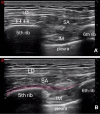Effect of Perineural Dexamethasone with Ropivacaine in Continuous Serratus Anterior Plane Block for Postoperative Analgesia in Patients Undergoing Video-Assisted Thoracoscopic Surgery
- PMID: 35992248
- PMCID: PMC9386172
- DOI: 10.2147/JPR.S372071
Effect of Perineural Dexamethasone with Ropivacaine in Continuous Serratus Anterior Plane Block for Postoperative Analgesia in Patients Undergoing Video-Assisted Thoracoscopic Surgery
Abstract
Purpose: The goal of this study was to evaluate the analgesic efficiency of dexamethasone with ropivacaine in continuous serratus anterior plane block (cSAPB) after video-assisted thoracoscopic surgery (VATS).
Patients and methods: Sixty-six patients who underwent VATS were randomized into two groups. All patients received cSAPB postoperatively, and patients in Group RD received 20 mL of 0.375% ropivacaine plus 0.1 mg/kg dexamethasone followed by an infusion of 0.2% ropivacaine plus 0.02 mg/kg/hour dexamethasone at a rate of 5 mL/h in patient-controlled analgesia (PCA) pump. Patients in Group R received 20 mL of 0.375% ropivacaine with normal saline followed by an infusion of 5 mL/h of 0.2% ropivacaine in PCA pump. Fifty milligrams of tramadol was given as rescue medication when the visual analog scale (VAS) score was ≥4 at rest. The primary outcomes were the sum of pressing number within 48 hours postoperatively and the time to the first patient-controlled bolus. The secondary outcomes were VAS scores, the incidence of rescue analgesia, wound infection and nausea/vomiting.
Results: Within 48 hours postoperatively, the sum of pressing number was more in Group R (18.33 ± 3.149 vs 16.09 ± 3.292, P = 0.006), and the Log Rank Test showed a significant difference in time to the first patient-controlled bolus (P = 0.006). After the PCA infusion finished, there were significantly lower VAS scores in Group RD at 60 and 72 hours postoperatively (P < 0.001). Additionally, the incidence of rescue analgesia in Group R was significantly more than that in Group RD (P < 0.001). No incision infection was observed in any patient.
Conclusion: The cSAPB with ropivacaine plus dexamethasone prolonged the duration of analgesia and motor blockade, reduced pain intensity and rescued analgesia requirements after the end of PCA infusion for patients undergoing VATS, which provide further improvement to continuous perineural block.
Keywords: continuous serratus anterior plane block; dexamethasone; levobupivacaine; video-assisted thoracoscopic surgery.
© 2022 Chen et al.
Conflict of interest statement
The authors report no conflicts of interest in this work.
Figures





References
-
- Horlocker TT, Vandermeuelen E, Kopp SL, et al. Regional anesthesia in the patient receiving antithrombotic or thrombolytic therapy: American Society of Regional Anesthesia and Pain Medicine evidence-based guidelines (fourth edition). Reg Anesth Pain Med. 2018;43(3):263–309. - PubMed
LinkOut - more resources
Full Text Sources
Miscellaneous

